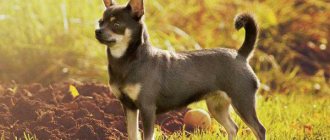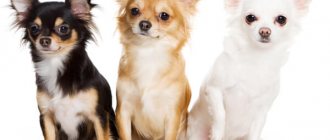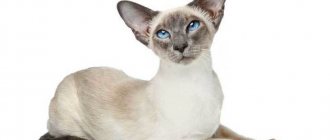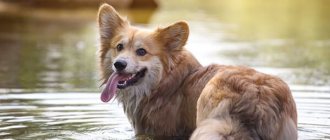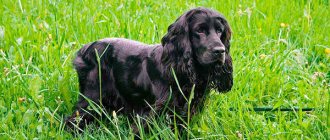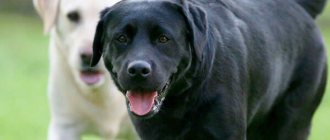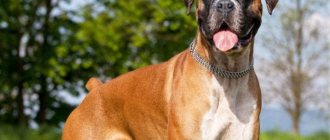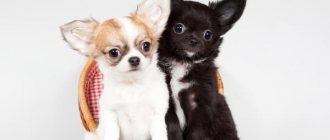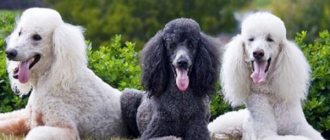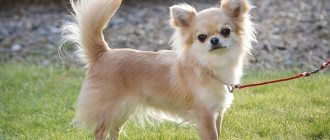Nowadays, it is not so common to see Chihuahua Deer, as most breeders prefer to breed Cobby type dogs.
But these graceful dogs have their admirers, who remain faithful to the classic type of the breed.
At first glance, Chihuahua Deer may seem too tender and fragile. In fact, they are in no way inferior to their stronger and more powerful-looking cobby relatives.
In the article we will tell you in detail about this breed of Chihuahua, and also show photos of these dogs.
History of the breed
When Chihuahuas appeared, there was no single breed type. Dogs could be of any color and build, and there were also differences in their sizes.
But at the same time, high-legged dogs had advantages - it was easier for them to hunt small animals living in the jungles of Mesoamerica, where their ancestors appeared in the 15th century BC.
Perhaps it was this feature that helped the long-legged and fast dogs of this breed survive difficult times, when, after the conquest of Mexico by the conquistadors, they again went wild and lived in the forests. When they were domesticated again by local residents, these small, graceful dogs became faithful and devoted companions for them.
In the middle of the 19th century, American travelers became interested in Chihuahuas and local residents began selling them puppies of this breed.
Read more about the history of the Chihuahua here.
NOTE!
Most of the first Chihuahuas brought to the United States from Mexico were more similar to the modern Deer type of dog.
Long-legged, deer-like dogs were popular until relatively recently, when stocky Cobby-type Chihuahuas began to be considered more conformable.
Divisions by height
The Chihuahua is the smallest dog breed in existence. This is confirmed by a super mini dog named Boo Boo, which has been included in the Guinness Book of Records for several years because of its small stature: ten centimeters in height and sixteen centimeters in length with a weight of six hundred and seventy-five grams.
But be that as it may, there is simply no such thing as “mini” and “super mini” in the standard of this small breed. And at exhibitions there are no names of such varieties. This is what this breed is called as a whole because of its miniature size.
In fact, micro dogs are nothing more than a disease of dwarfism or the consequences of premature birth. Unscrupulous breeders are happy to sell these very small dogs and confidently call them new trends in the breed. How much such a dog will cost depends only on the greed of the seller.
When buying a micro dog, you are unlikely to be able to breed them in the future, and they will not pass the basic standards. This means they will not be able to participate in exhibitions. They live much shorter compared to purebred Chihuahuas, up to a maximum of ten years. At the same time, it is even difficult to imagine how much effort will have to be made for such a dog to live to such an age. Standard dogs live an average of twelve years.
Super micro dogs often have the following disadvantages:
- fragile body structure;
- incomplete set of teeth;
- undershot;
- too large fontanelle;
- weakened immunity.
Dwarfism is quite normal for this breed, but in moderation. Chihuahuas that are too underweight usually do not live longer than ten years. If you decide to take such a brave step as buying a super micro Chihuahua puppy, then first of all think about how much effort you will have to put in to constantly care for and monitor your tiny pet. Here are the basic rules that must be followed:
- Do not drop the mini dog;
- always look under your feet so as not to accidentally step on an animal, especially if it lives in an apartment;
- children should not play with it - the slightest injury can cost the pet its life;
- do not take your super mini baby on the bed with you so that he does not fall from there;
- Such dogs should not play with other animals to avoid injury;
- For such puppies, veterinarians provide a special feeding regimen, for example, they cannot eat pearl barley or drink milk, as this can lead to serious digestive problems.
At first, food for a dwarf dog will have to be chewed by the owner and given only in this form. These super mini dogs don't live long, especially if you miss a couple of feedings. In this case, the pet may experience hypoglycemia, as a result of which the dog’s movement coordination is impaired, followed by convulsions, which sometimes leads to the death of the animal. This condition can cause any kind of anxiety.
Regardless of any characteristics and differences of your dog, you must always properly care for it, groom and cherish it. Each Chihuahua is individual, but she will always respond to your love with devotion, adoration and obedience.
What body type and color does your Chihuahua have? Does your dog fit the standard?
Description of character
The Chihuahua Deer is a small, elegantly built dog. She looks elegant and sophisticated, and her movements are light and free. When such a dog runs, it seems that it almost does not touch the ground.
Chihuahua Deer are smart and very understanding. These are active and playful dogs that, despite their apparent fragility, are resilient and quite strong.
They are selflessly devoted to their owner, friendly and affectionate towards him. But they are wary of strangers.
Chihuahua Deer make good guards. Despite their small size, they are always ready to protect their owner or his property.
Distinctive features
Distinctive features of dogs of this type are:
- the head is relatively small in size, slightly elongated in shape;
- elongated muzzle;
- large and high-set ears;
- deep, but not wide chest;
- rather long paws;
- long and thin tail;
- the angles of the articulations are less pronounced than those of the cobby;
- There is no sense of strength or power in the movements of Deer type dogs.
Deer-type Chihuahuas do not have well-developed muscles, which makes them visually more sophisticated than representatives of the Cobby type.
Accepted standard type dir
The size of a standard Chihuahua Deer should be no more than 23 cm at the withers. Weight ranges from 0.5 to 3 kg.
The Chihuahua Deer is a small, square dog with a light bone structure.
The head does not look large or convex. The transition to an elongated muzzle is pronounced, but not sharp.
The ears are large and rather thin. They are set high, which gives the dog a resemblance to a fawn.
The eyes are relatively small, slightly convex. Their most preferred color is dark shades of brown.
The nose color is black or matches the base color.
The neck is quite long and narrow. The back is straight, not wide, merging into a slightly sloping croup.
The chest is deep enough, but not too voluminous. The stomach is tucked.
The limbs are parallel, due to the lack of pronounced muscles, they appear thin and long.
The tail is set quite high, long and thin.
The coat is soft, can be either smooth or quite long, but not fluttering.
According to the breed standard , all colors except merle are considered acceptable for Chihuahuas.
Expert opinion
Kozhevin Semyon Kirillovich
Expert dog handler.
Deer-type dogs are on the verge of the standard. Many Deer Chihuahuas look more like small greyhounds than their own breed. This dog is a representative of the classic breed type, which has existed for centuries and was incredibly popular back in the first half of the twentieth century. However, the exterior of such dogs should not have the excessive lightness of build and stylization inherent in many modern Chihuahua Dires.
Types of colors
Now let's talk about the colors characteristic of the breed. The variety of coat colors of these super small dogs is simply enormous. Even the most picky buyer will be able to find a puppy color that suits his taste. But there is one important rule - the dog’s eyes and nose should always match the shade of the hair.
The dog's mask may be absent or located in different places on the face. The size of the mask may also vary.
Among the variety of shades, modern fashion gives preference to white, chocolate, sable, black, wolf, and red colors. Two-color and three-color dogs also look beautiful. Particularly beautiful is the rare blue Chihuahua, whose eye color is similar to ruby. In general, there are as many colors as you like.
How is it different from a cobby?
The Deer differs from the Cobby-type Chihuahua in its greater grace and lightness of structure.
The head of the dir is less voluminous, and the muzzle is longer.
The position of the ears is also different - in the cobby they are low and relatively small in size, while in the dir the ears are large, thin and high-set.
Differences in Temperament
Chihuahuas have an extremely stable psyche, which reaches its development within a year. It is difficult to find cowards and hysterics among them, although of course there are exceptions - as many dogs as there are, so many peculiarities. For the owner, this dog will become a wonderful companion and a faithful, sometimes jealous friend. But some representatives of the breed, depending on the different type of coat, may have different behavioral characteristics.
It is believed that dogs with a long coat type have a soft and flexible character and a calmer temperament. Whereas Chihuahuas with short hair are often quick-tempered and live a more active life.
Advantages and disadvantages
Pros:
- look sophisticated and elegant;
- sociable and playful;
- are distinguished by loyalty and love for their owners;
- They make sensitive watchmen;
- do not need a large living space;
- if you accustom your Chihuahua Dir to a tray or diaper, then you can forget about walks in inclement or too cold weather;
- do not require complex and time-consuming care;
- You can take such a dog with you on any trip;
- smart and trainable.
Minuses:
- You cannot buy such dogs for families with children;
- may be injured during a jump or fall;
- if not properly raised, they can show aggression even towards their owner;
- monogamous - they recognize only one owner in the family;
- can bully other people's dogs on the street;
- sometimes they are quite jealous;
- They don't like dogs of other breeds.
IMPORTANT!
When training a Chihuahua Dire, it is necessary to take into account that physical methods of influence cannot be used during training.
Basic rules of care
The coat of a smooth-haired dog should be combed with a brush two or three times a week, and during the shedding period - daily. It is recommended that long-haired Deer Chihuahuas be combed with a comb every day.
It is not necessary to bathe these dogs often, and it is better not to wash them at all unless necessary.
Your pet's ears and eyes should be examined every day in order to notice the first signs of inflammation in time. They only need to be cleaned if they become dirty. Nails should be trimmed with a nail clipper once every six months.
To clean teeth, your pet should be given chewing toys or treats designed to remove plaque.
Due to the fact that the deer has an accelerated metabolism, these dogs need warm clothes even in cool weather, and the pet must wear them indoors.
NOTE!
Chihuahua Dire is not intended for street keeping - such a dog should only live in a house or apartment.
Types of wool
The Chihuahua's coat differs only in the length of the pile. There are two types of wool:
- long;
- short.
First type
The long-haired Chihuahua has a fine hair structure. Due to the large length of the coat, such dogs are also called hairy. This type of wool is very soft to the touch.
The “jabot” or fluffy collar looks very beautiful on the Chihuahua’s neck, just like the “pants” on the paws. The fur on the tail is especially thick. The long hair on the ears forms a fringe. On the body, the straight coat is not particularly long, and when touched it is not at all rough.
Curly hair is not allowed by the standard, except for light waves. Also, according to the standard, the undercoat may be absent, although in many cases it is quite developed.
Second type
Short-haired super mini dogs are usually called smooth-haired because this type of hair is very smooth. This structure is also characterized by short, even hairs that fit tightly to the Chihuahua’s body. The coat of this species is very beautiful: shiny, soft and silky to the touch.
Individual hairs may be longer in the neck and tail area. And in the throat area the wool is thinnest. As with other types of wool, the standard allows for the absence of undercoat. Sometimes, in places where the fur is shortest, skin can be seen.
So there are only two types of coat, which are indicated in the standard. If a super mini dog has a mixed or intermediate type, then such an individual is unlikely to fit the parameters of the standard.
How to choose a puppy?
Despite the fact that most modern breeders breed Cobby Chihuahuas, it is still quite possible to find Dire puppies with documents.
When choosing a future pet, you need to pay attention to the structure of its muzzle and head - while cobbies have a convex skull, dirs have an elongated one. The muzzles of this type of Chihuahua are quite long, the ears are larger and set high, and the eyes are not very large and less rounded than those of the Cobby, and this is noticeable already at an early age.
IMPORTANT!
The Chihuahua puppy should have a balanced psyche and should not have even the slightest signs of illness.
What dog experts say
We have described the standard types and types into which Chihuahua dogs can be divided. In addition, there are many nuances that will help you not make a mistake in choosing a pet and buy exactly the dog that you originally wanted.
Firstly, it is worth considering the fact that there are a lot of unscrupulous breeders. There are breeds that are not recognized by the standard, but they are often passed off as the standard type of Chihuahua. These, for example, include the Pekingese, Aboriginal, English, Extreme, and Exotic types. All these breeds are not recognized by the standard and are considered defective. And it’s not surprising, because many of the above breeds could have been bred only to see what would happen if the dog had non-standard proportions.
Related article: How and when to vaccinate Chihuahua puppies
For example, an extreme type Chihuahua has really extremely short legs, on which it cannot even walk properly. Thus, all these types are not included in the standard, and life is very difficult for animals of such breeds. Of course, you can buy such a dog, but it will require special care, and you definitely won’t be able to send it to an exhibition.
Secondly, if you want to buy a pet to participate in exhibitions, it is recommended to choose a cobby type. Although, according to dog experts, this type is rarely seen in its pure form now, so if you want to assess the prospects, look at the baby’s parents and evaluate their successes at exhibitions.
The last thing worth saying is that you should not opt for a low price. Of course, it is not a fact that if you buy a dog for a lot of money, this acquisition will be successful, but the likelihood of becoming the owner of a sick puppy by purchasing it for a low price is extremely high. Therefore, carefully check from whom and for what amount you will purchase a pet. And if you decide to buy a dog with health problems, make sure you know exactly what’s wrong with it and how it can be cured (and whether it can be).
